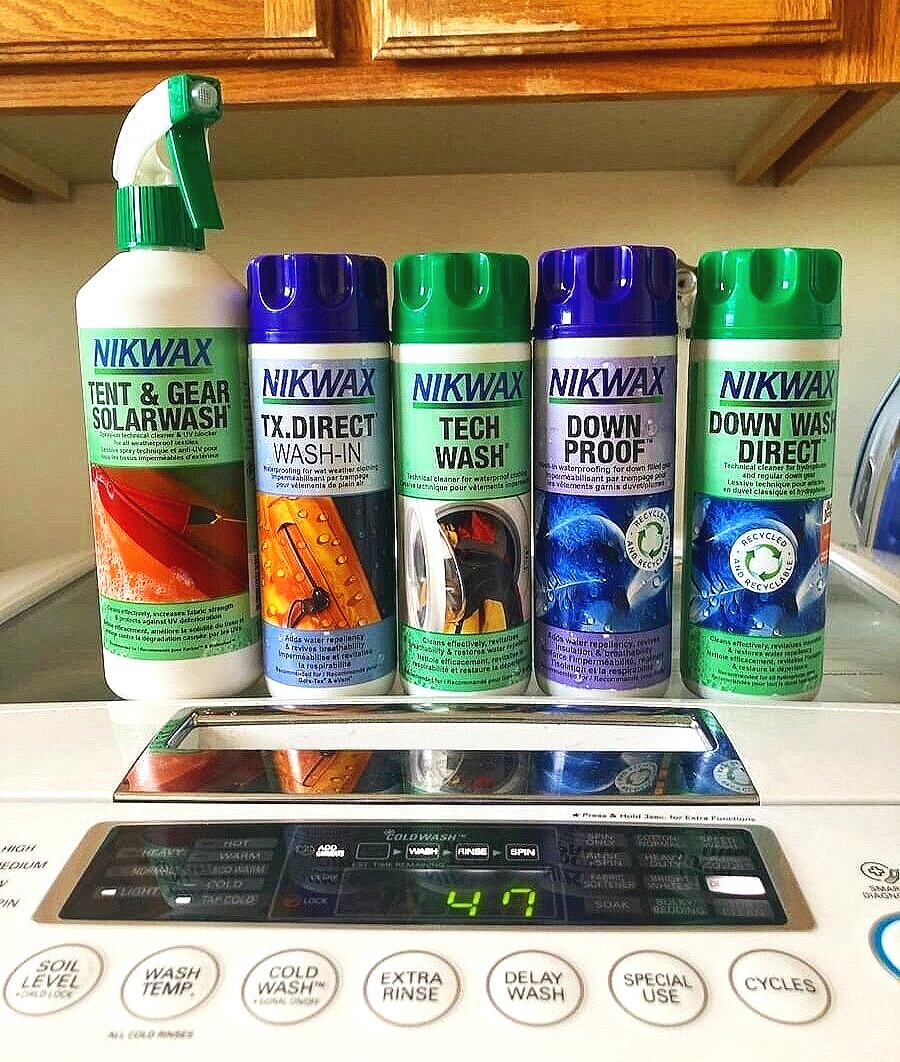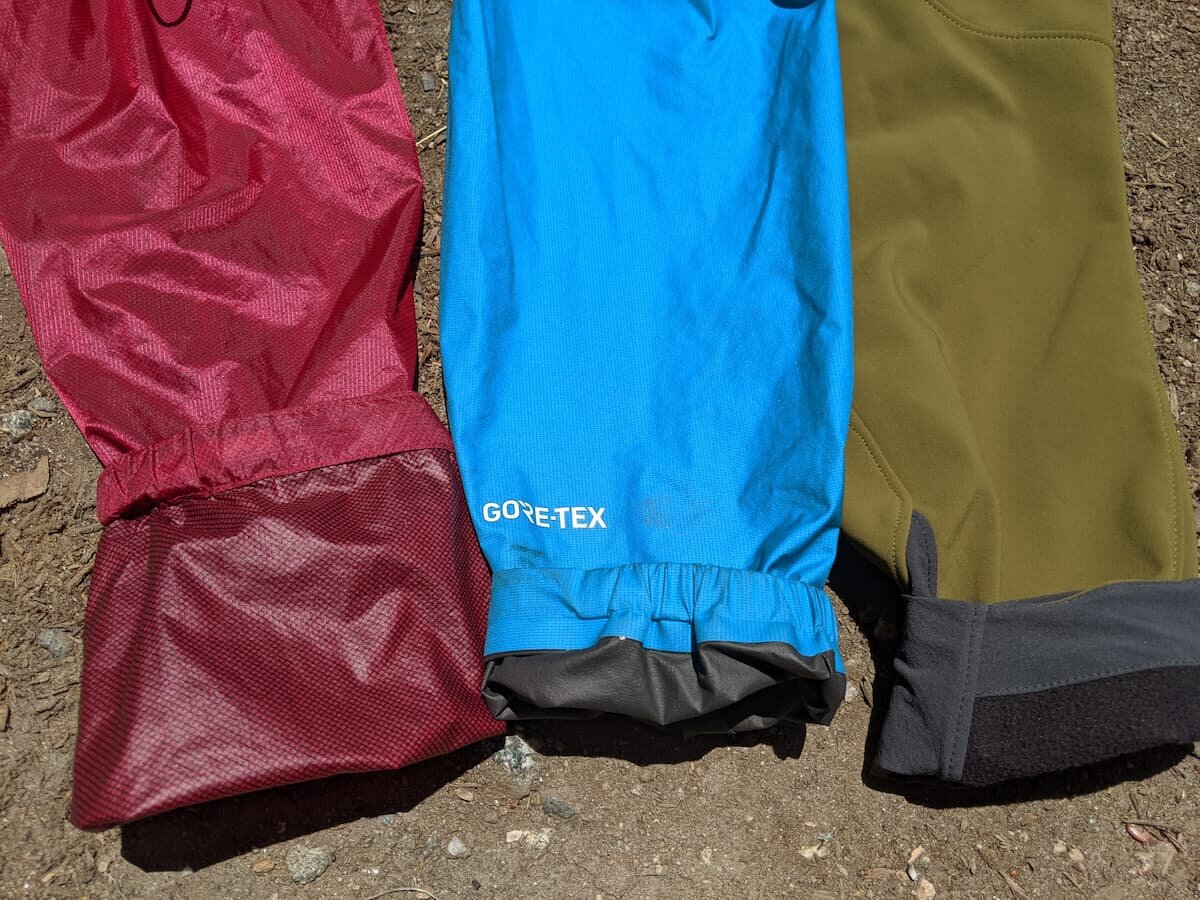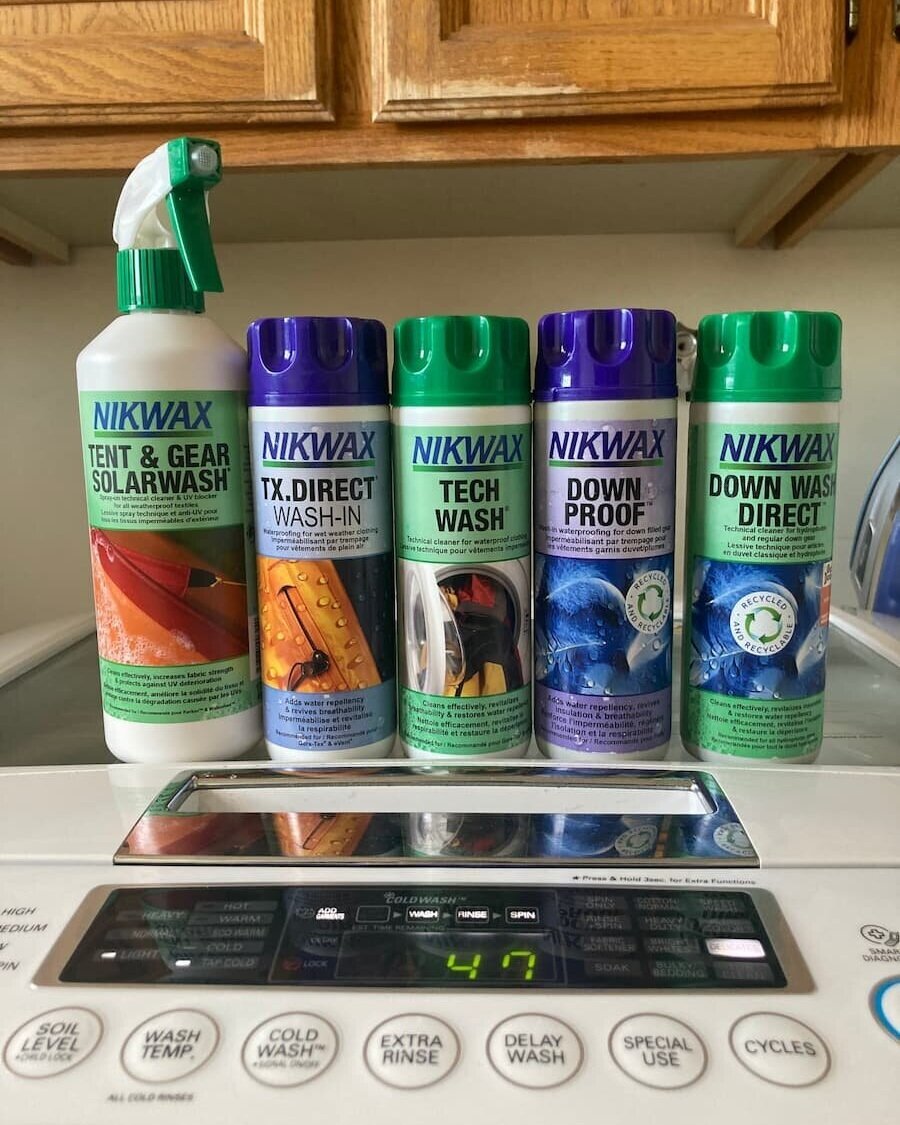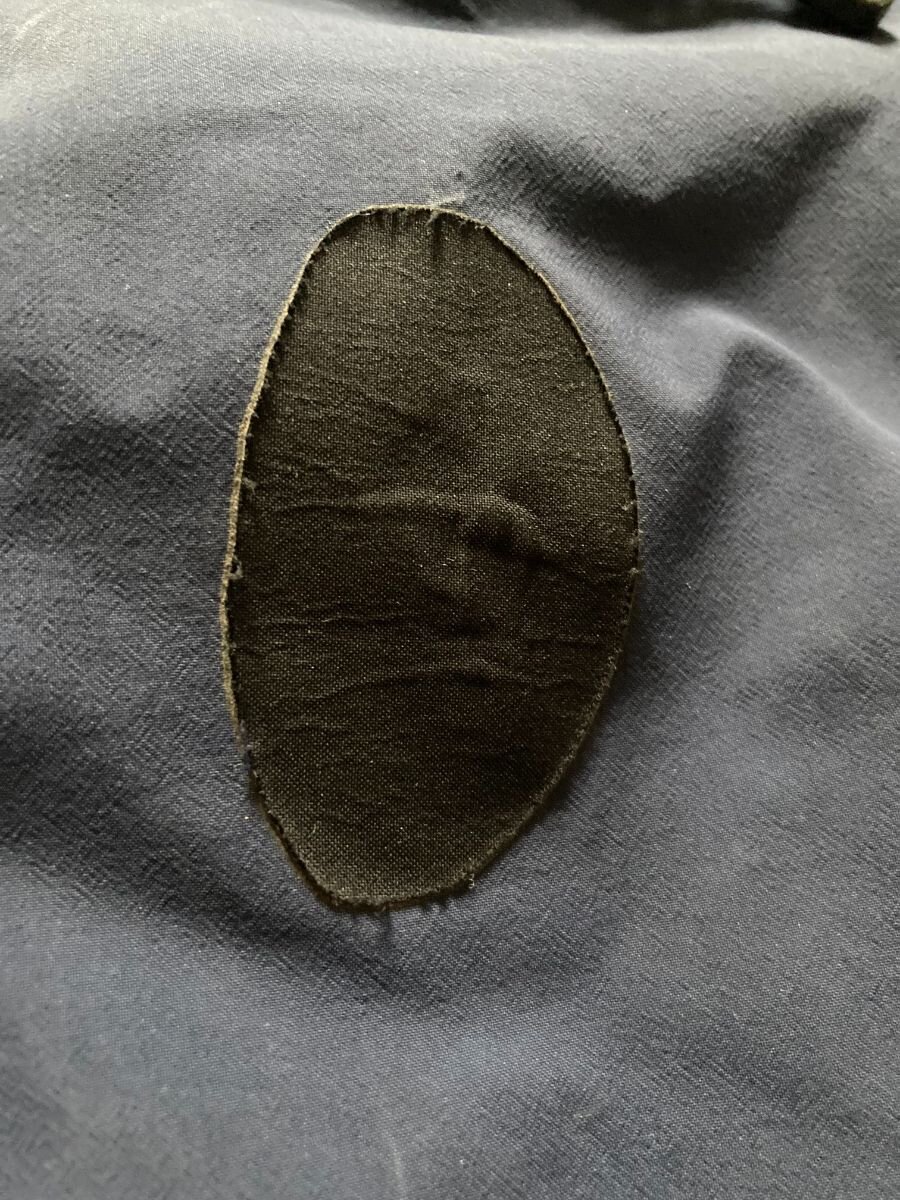How to Clean and Repair GORE-TEX and Other Shells
Get the most life out of your WATERPROOF OUTERWEAR
January 26th, 2025
Home > Learn Skills > Cleaning, Repair and Maintenance
A good hardshell, waterproof-breathable jacket is a worthy investment for avid outdoors people. It will stand up to the worst of elements, from sideways rain and ripping wind to winter storms; it will also cost you a pretty penny.
For that reason, it’s worth taking care of your hardshell outerwear—whether it’s GORE-TEX, eVENT, or a brand’s own waterproof breathable shell material.
Regular proper cleaning and repairing holes when necessary will help your investment last as long as possible (up to decades!) and is better for your wallet and the planet. By washing and caring for your hardshell and softshell jackets, you can keep getting outside no matter the weather.
Related: Best Men’s Ski Jackets and The Best Women’s Ski Jackets
Read More: How to Fix Zippers on Outdoor Gear
Snow and moisturing piling up and beading off of a GORE-TEX jacket. A GORE-TEX or Hardshell Jacket should be able to last a decade of adventures with good care. Photo courtesy Stasia Stockwell.
Anatomy of waterproof-breathable shells
Waterproof-breathable hardshell clothing, such as GORE-TEX, eVent, and similar shell materials, are made from multiple layers of fabric:
a face fabric (sometimes called the garment's outer fabric).
a waterproof membrane laminated to the interior of face fabric
a protective layer next to skin fabric or coating
DWR coating (Durable Water Resistant) on the face fabric.
These layers work together to shed moisture while simultaneously allowing body heat and sweat to escape. This layered design is how outdoor garments keep you dry, while still allowing for breathability to mitigate sweating and overheating.
Rain jacket (left) vs. a GORE-TEX Paclite jacket vs. a softshell (right). Cuffs rolled up to show interior fabric.
Hardshell vs. Softshell vs. Rain Jacket
Hardshells, softshells, and rain jackets can all be classified as waterproof jackets.
Hardshells, softshells, and rain jackets differ from most insulated jackets that lack shell waterproofing.
Most down jackets and synthetic insulated jackets come with some DWR treatment but are not a laminate or coated shell.
Hardshells
Hardshells (also sometimes called “shells”) are designed to be the first layer of protection against the elements like rain, snow, and wind. Examples of hardshells are men’s and women’s ski jackets. You’ll find the same hardshell material in men’s and women’s ski pants, too. The care and maintenance for hardshell jackets and hardshell pants is similar.
Softshells
Softshells, are often made of a softer, woven, and stretchier material and can be worn as a midlayer under a hardshell or as a first layer in milder conditions.
Rain jackets
Rain jackets differ from hardshell in their construction. Hardshells refer to waterproof, windproof jackets that have multilayer laminate construction. That makes them different from many rain jackets or other waterproof breathable garments that use a spray-on coating on the inside of the face fabric. You can learn more about waterproofing technology on this article on how rain gear works.
Laminate vs. Coated Waterproof jackets
Laminate and coated waterproofing differ in price and performance. Laminate technology is almost always more expensive than coated technology, but it makes up for it by lasting for multiple years of use.
A typical user may get 1-3 years of use for a coated shell.
A properly maintained laminate (like GORE-TEX) shell can last 10-20 years.
Two examples of coated vs. laminate technology:
The Marmot Precip rain jacket (a top jacket in our Best Rain Jackets Guide) uses coated technology instead of laminate.
A GORE-TEX jacket like the Arc’teryx Sentinel or Arc’teryx Sabre (top jackets in our women’s ski and best men’s ski jacket reviews) use laminate.
For more information, this is a good article on how different jackets differ in waterproof technology.
Care and Maintenance for Shells
Although simpler and less expensive spray-on coated rain jackets are not as long-lasting as hard shells with laminate construction, most will still benefit from the same care and maintenance as GORE-TEX, eVent, and other laminate jackets.
The following are the main steps to care for shell jackets:
1) Be sure to wash your gear—even if it has coated waterproofing. Waterproof-breathable membranes can become less effective when clogged up with body oils or dirt. We describe below how to properly wash your GORE-TEX, eVent, or coated waterproof gear.
2) Treat with a durable water repellent (DWR) treatment on the face fabric. They can wear off over time, but do make a noticable difference.
3) Repair damage. While outdoor apparel is designed to be durable, there are certain things you can do to care for and maintain the function of these items such as washing and patching holes or reapplying water repellent DWR. We describe patching and repairs below.
Using the right cleaning agent is essential to prevent your shell membrane from clogging. Photo courtesy Stasia Stockwell.
How to clean RAIN shells and gore-tex ski gear
Dirt and oils are one of the main reasons that waterproof and breathable rain shells begin failing.
The primary function of the interior layer of GORE-TEX, eVent, or other shell fabric is to protect the membrane’s pores from becoming clogged with oils and dirt.
Washing your rain shell jackets and pants can do a lot for the performance of the garment, as long as you do it correctly with the proper cleaning agent.
Even a mild detergent commonly used for household laundry can damage the waterproof membranes and coatings used in outdoor gear, as can certain types of washing machines.
Here’s how to properly clean your shells:
Step 1. Confirm Care Instructions
Before heading straight to the washing machine, read the tags or check the company’s recommendation for cleaning to be sure you’re not going to damage the garment.
While most waterproof-breathable shells require similar washing methods, it’s best to confirm instructions for each particular piece before you toss it into the wash.
Step 2. Prepare Your Washing Machine
Generally, front-loading washing machines are best for washing outdoor apparel.
Top-loading washers can also work as long as they do not have an agitator in the center. Agitators can damage your outerwear, so never use a washing machine with an agitator to clean your outerwear.
If you don’t have the right kind of washing machine at home, consider going to a laundromat with commercial front-loading washers.
Whether you are washing at home or in a laundromat, be sure that all detergent and bleach compartments are clear of residue from powder detergent or liquid detergent build-up before washing.
It's also a good idea to run a washing cycle with no detergent added to clear the machine of harsh chemicals before laundering your garments.
Step 3. Use the Right DETERGENT
Find the right cleaning solution for your garment. Even a mild laundry detergent can degrade outdoor clothing’s effectiveness, so be sure to get something that is specifically formulated for cleaning outdoor shell garments.
For a GORE-TEX garment or outdoor gear that uses similar shell materials, we recommend Nikwax Tech Wash. This water-based cleaning agent is biodegradable and free of harmful chemicals but still tough enough to get even your most-loved jacket clean. We use it for everything from GORE-TEX rain jackets to ski pants and even softshell apparel.
Step 4. Prepare Your Garments
Check that all pockets are empty in pants and jackets. Zip up all zippers, including the main front zipper, before adding garments to the washer. This will help keep zippers and the technical fabric from getting too bunched up in the wash.
Step 5. Washing Gore-Tex
Follow instructions on the label for the cleaner you’re using. If you’re using a top-loading washing machine, start the wash and let it fill with some water. Then, add your cleaner before adding garments.
Only wash 2-3 pieces per load, unlike your typical laundry load.
Do not use a fabric softener or stain removers as it can compromise the membrane on your eVent or GORE-TEX gear.
If your jacket could benefit from using stain removers, spot clean using the same technical liquid detergent you are using to wash your shell.
Most shells will need to be washed in warm water on a gentle cycle since the heat helps revive the waterproof-breathable GORE-TEX membrane. But, again, be sure to check the tags and the care instructions on the proper cleaning solution first. Use only a low spin cycle at the end of the wash cycle for outdoor garments. This will be gentler on your garments.
Step 6. Optional: Additional Waterproofing (DWR)
After the wash cycle is complete, you can either dry your garments or do an additional waterproofing treatment for them.
Wash-In waterproofing solutions like Nikwax TX.Direct or GEAR AID ReviveX add waterproofing to garments with worn water repellent coatings. Like the Tech Wash, this waterproofing solution is biodegradable and free of harmful chemicals. This will require you to do a second wash where you add the additional waterproofing treatment to the garment. Wash-in solutions also may last longer than spray-on options. However, depending on your garment and fabric, it may compromise the liner and the pores of the eVent or GORE-TEX membrane.
Spray-on options like the Nikwax TX.Direct Spray or GEAR AID ReviveX DWR spray are applied only to the face fabric exterior. Be sure to follow the instructions for washing and drying to get the best results.
WASH-IN DWR VS. SPRAY-ON DWR
The brand that makes your jacket may have recommendations on whether wash-in or spray-on is better for their particular garment. For example, Arc’teryx’s website advises against wash-in solutions. We recommend a spray-on as it is less likely to compromise the wicking of the liner and pores of the membrane.
For more info, REI has an article on Durable Water Repellent (DWR) treatments for rain gear.
Step 7. how to Dry Gore-Tex jackets
After washing and adding a water-repellent solution, if needed, you’ll dry the garments. Again, read tags and instructions first.
For most waterproof-breathable shells, you’ll want to dry completely on low heat in a tumble dryer. The heat helps to restore the function of the DWR treatment on the jacket’s face fabric, so the dry cycle is an important step.
Low heat in a tumble dryer is also a great way to ‘cure’ a newly applied wash-in or spray-on DWR treatment.
Direct sunlight while hanging garments up to dry also does the trick, but be careful not to dry your GORE-TEX gear in excessively high heat as it can compromise the laminated membrane.
After your jacket is clean and dry, enjoy getting out in the elements with revived shell pants and jackets.
This GORE-TEX jacket is patched (see patch on side of jacket) and back in commission on the mountain. Photo courtesy Stasia Stockwell.
How often should I wash outdoor gear?
It is not necessary to wash outdoor gear, like shell jackets and pants, after each use. Aim to wash your shells a handful of times throughout the year, or anytime after a garment gets particularly dirty. Use DWR waterproofing treatments only when you notice that water droplets no longer bead up on the fabric and instead get absorbed into it. You should not need to do this until the garment has gotten a good deal of use.
According to this article by REI, more gear becomes PFAs and PFC-free, the new Durable Water Repellents are less durable. This means they will need to be washed and had DWR added more frequently. For more, see our guide to PFAs and PFC-free waterproofing.
Washing your gear is an important way to extend the life of your gear so you buy less. For more environmentally-friendly gear recommendations, see our guide to Used Gear: An environmentally-friendly alternative to buying new.
A GORE-TEX or shell patch is preferable to general gear patches. Trim your patch to the correct size and shape for your tear or hole. Photo courtesy Stasia Stockwell.
How to repair holes in shells
It happens: At some point, you’ll snag a tree branch or scrape a sharp rock and you’ll tear your beloved shell jacket or pants. The good news is that patching shells is pretty easy, as long as you have the right patch in your repair kit. And every new patch on your outerwear might at least have a good story to go with it, right?
We also discuss repair tape and patches in our Eco-Friendly Gear Swaps to Reduce your Footprint guide as well as our How to Repair Down Jackets and How to Repair a Tent guide.
We think patches are an essential part of a field repair kit. Although the patching process is similar for most gear, these specific tips will help you get the most out of repairing your hardshell.
Step 1. Find the right patch
Make sure you have the right type of patch for your shell jacket. If your garment is GORE-TEX, you can use a GORE-TEX-specific patch, though regular patches will also work. This is where you’ll want a different patch than what you’d use to repair a down jacket or tent.
While duct tape patches will work for emergency field repairs, it's worth replacing them with a patch when you return home. Whether in the field or at home, always apply patches to the outer fabric.
Step 2. Wash Before Patching
Patches or duct tape can work in the field in a pinch, but for a better repair, it’s best to wash your garment before patching. See above for detailed instructions on washing GORE-TEX and shells.
Although it will be more conspicuous, it’s best to cut patches to at least half an inch larger than the tear or hole. Photo courtesy Stasia Stockwell.
Step 3: Cut and Size Your Patch
If the patch is part of a roll of tape or a larger sheet, cut it to the appropriate size to cover the hole. The best practice is to cut the patch to a shape with rounded corners rather than square. Extend the patch at least a half-inch larger than the hole or tear.
Step 4. Apply and iron your patch
Apply the patch to the outer fabric of your clean garment. Pay attention to instructions on the specific patch you’re using. For a larger hole, consider applying an interior patch, too. Most patches will require or recommend gentle ironing on low heat to help the patch adhere.
Once you’ve applied and ironed the patch, you’re ready to get back outside! If you can give it a day or two to cure before use, that’s ideal.
Sometimes, GORE-TEX jackets need professional care to get back outdoors. Photo courtesy Stasia Stockwell.
When you can’t fix it yourself: brands that offer warranties and repairs
Sometimes your outdoor apparel may be beyond self-repair. Or, maybe you’d prefer to leave it to the professionals.
Holes or tears that are large enough to compromise the structural integrity of a garment should be professionally repaired.
Examples? Four-inch tears in the GORE-TEX fabric at the knees, seat, or elbow. The adhesive of patches will not be sufficient to hold these together. They need professional sewing.
There are several companies that offer cleaning and repairs for their apparel.
MAIL-IN SERVICES
Patagonia offers repairs on any of its items. Most repairs are free, though some highly technical garments or tricky repairs may incur a small charge. Patagonia asks that you clean your gear before sending it in for repair.
Arc’teryx offers repairs as well as cleaning on any of their technical apparel. Items that meet warranty requirements will be repaired for free; those that don’t can be repaired at a reasonable price. Arc’teryx will also clean your garments for an added, reasonable cost.
REI Repairs partnered with Washington-based Rainy Pass Repair Inc. to address issues on your tent, jacket, backpack, or sleeping bag. As a third party, these services are not free but are a great resource for cleaning and repairing gear that is not warrantied by the maker.
Feathered Friends can repair the sleeping bag zipper on your Feathered Friends bag or quilts as well as broken zippers on Feathered Friends jackets. They also offer a cleaning service.
Rugged Thread is an outdoor gear repair shop based in Bend, Oregon but accepts mail-in orders. In addition to apparel, they can also repair zippers on your tent, backpack, or sleeping bag. Their zipper repair service is able to address issues like separating zippers, a damaged coil zipper, or broken teeth. Rugged Thread partners with brands to complete warranty and customer service repairs, so some repairs may be free.
LOCAL SERVICES
Working with a local gear repair business is a good way to extend the life of your outdoor equipment as you are able to show specialists exactly where and what issues need fixing.
Six Moon Designs maintains the most extensive list we’ve found of quality local outdoor gear repair shops around the US. It’s worth noting that not all sewers or tailors have the machinery and skills to repair outdoor gear, which often uses thicker and sometimes lighter-weight fabrics than everyday clothing. Six Moon Designs’ list includes outdoor gear repair shops in 17 different states, so you’re likely to find one in your region that can provide the services you need.
The author wearing the PFC-free, 3-layer Gore-Tex Patagonia Untracked ski jacket. Photo courtesy Stasia Stockwell.
What about PFAs and PFCs in waterproof outdoor gear?
What are PFAs and PFCs?
Polyfluoroalkyl and perfluorochemicals (commonly referred to as PFAs or PFOAs or PFCs) are commonly found in waterproof and water-resistant outdoor apparel and gear. The EPA lists chemicals in this group as “forever chemicals,” meaning they remain or decompose very, very slowly in the environment and never biodegrade.
Many DWRs (durable water repellents) contain PFCs, as do most products with a GORE-TEX membrane.
These PFCs and PFAs do not necessarily enter your body when you wear outdoor gear that uses them. Instead, those who work to produce this gear and the raw materials are the most affected by these chemicals since they’re working directly with them day in and day out. You can read more in our article about PFAs and PFC-free waterproofing in outdoor gear.
Are there PFCs and PFAs in my waterproof outdoor gear?
REI announced that it would ban “forever chemicals” (including PFAS) from all cookware and apparel sold in the store starting in 2024.
Similarly, the outdoor industry is shifting away from these materials. States like California are moving to ban these substances from consumer goods, outdoor apparel included. Patagonia is leading the way on jackets made without fluorinated alternatives, including the GORE-TEX ePE membrane found in their Storm Shift line.
Many brands, Patagonia included, have used PFC-free durable water repellents (DWRs) for a few years, and others, including Arc’teryx, have launched small lines with the new PFC-free GORE-TEX membrane. Brands including Picture Organic, Stio, Fjallraven, Outdoor Research, Cotopaxi, and Mammut have some PFC-free DWR options.
How to wash my waterproof gear with pfas
It’s equally important for our gear to be durable and last a long time in order for them to be more sustainable. So far, there is some evidence that it’s better for the environment (and your wallet) to refrain from buying a new jacket. Instead, wash and care for your old jacket as long as you can. You can read more on whether to replace gear in our article on PFAs and PFC-free waterproofing
All of Nikwax’s line of washes and DWR treatments are now PFC-free, including TX.Direct, which is commonly used to re-up waterproofing in outdoor garments at home. You can also buy a PFC-free Hardshell Outerwear Kit when it’s time to revive the waterproofing.
For PFC-free treatments, use the directions in this story as usual.
How to Wash my PFAS-Free Waterproof Gear
If you have one of the PFCs/PFAS-free ski shells or rain shells, that’s great! Patagonia’s care page has instructions for washing GORE-TEX and H2No fabrics, which are free of PFCs/PFAs.
Why You Should Trust Us & About the Author
Stasia Stockwell is a lifelong skier who has spent an average of 50 days skiing each season since she could walk. She has taken classes on all-mountain skiing techniques and has her AIARE Level 1 avalanche safety certification. Her work in the industry spans from testing and reviewing skis for Backpacker Magazine to working on ski videos for Atomic skis.
Stasia has written for Backpacker Magazine, REI Co-op Journal, The Dyrt Magazine, and more. You can find more of her writing, gear reviews, and adventures on her website. You can see all of Stasia's Treeline Review stories on her author page.













